Affiliate disclosure: This post may contain affiliate links. Please see our Privacy Policy.
Honey Fermented Ginger is an easy, effective, and delicious way to turn two common kitchen ingredients into a natural remedy that can support your immune system, aid digestion, and reduce inflammation. If you’re looking for a simple, powerful home remedy to keep in your pantry, look no further than honey-fermented ginger.
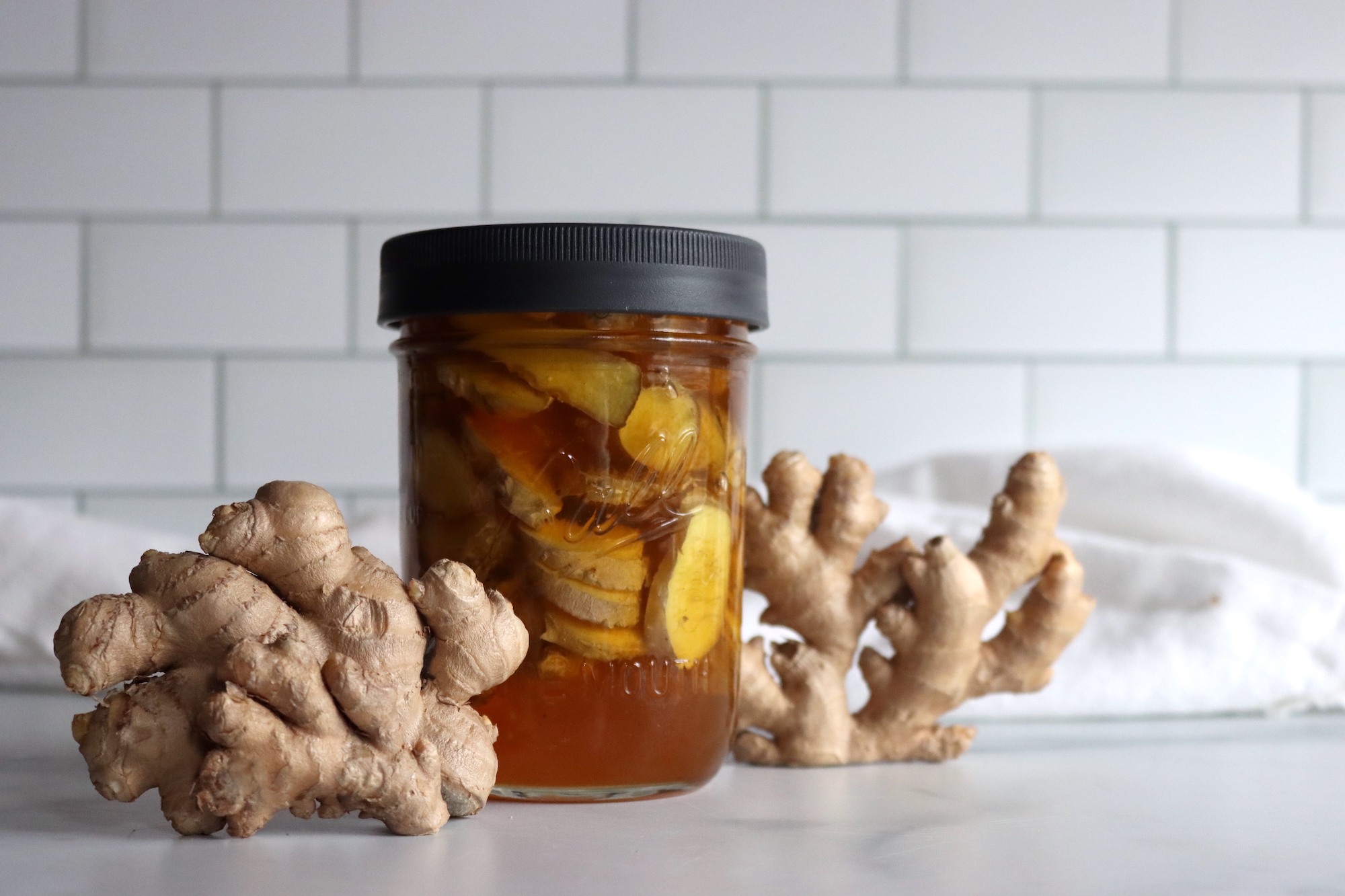
A few years ago, I discovered the benefits of fermenting in honey, and it makes amazing natural remedies (and tasty treats, too). Honey contains natural enzymes and yeast, and when you add fruits, roots, or herbs that contain water, those natural probiotics can go to work, creating a delicious and nutritious ferment that both preserves and enhances flavors (and medicinal components).
Honey-fermented garlic is a well-known variation, and I know it sounds strange, but it’s surprisingly delicious. The garlic transforms into a complex, sweet, and spicy treat that’s a great snack right out of the jar. And, of course, you then get the medicinal benefits of both the honey and the garlic, plus probiotics from the ferment.
Ginger is already well-known for its medicinal properties, and when combined with raw, natural honey, it becomes an even more potent remedy. Its warm, spicy kick is known to aid digestion, ease nausea, and fight inflammation. And when fermented in honey, these benefits are enhanced and transformed into an easy-to-use natural remedy.
We grow fresh ginger here on our Vermont homestead, and have raised bees for their fresh local honey, so this particular remedy is one that’s easy to source right from our own yard. (You can buy ginger for planting here, and they have Turmeric for planting as well. Both grow in similar conditions and do well indoors year round, or outdoors in summer.)
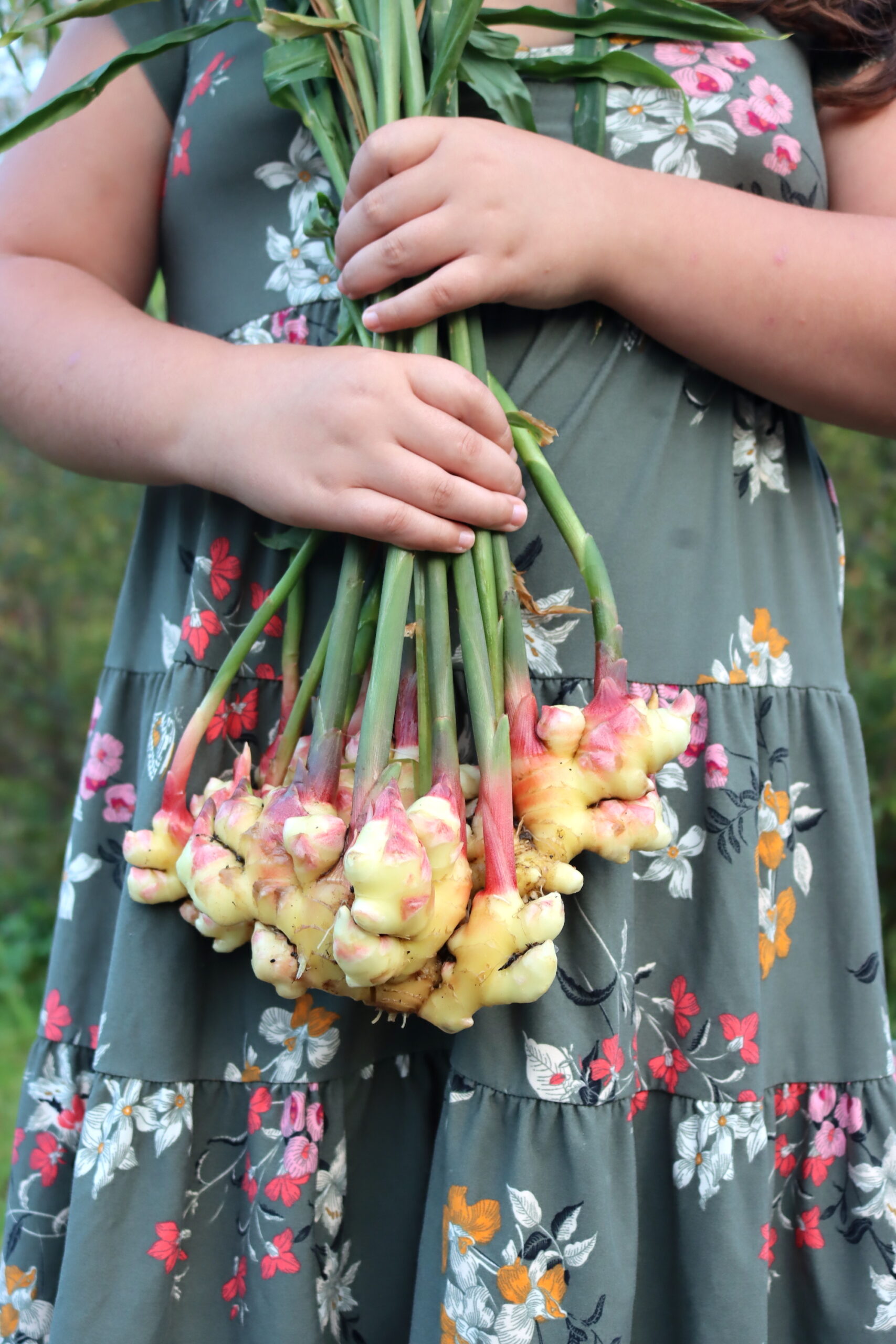
What is Honey Fermented Ginger?
Honey fermented ginger is a simple recipe where fresh or dried ginger root is placed in raw honey and allowed to ferment for several days. The process of fermentation increases the potency of the ginger’s health benefits while adding a unique flavor to the honey.
Just like garlic, ginger has its own natural microorganisms that help to kickstart the fermentation process. The honey provides an environment for these microbes to thrive, and over time, they break down the ginger’s active compounds, making them more bioavailable. The result is a more potent, easy-to-digest remedy that’s not only good for you but also delicious.
Honey is naturally rich in beneficial microbes, while ginger contains its own unique strains of lactobacillus and other beneficial bacteria. As they ferment, these microbes help to increase the bioavailability of ginger’s nutrients, while also creating a probiotic-rich elixir that can help soothe digestive discomfort, reduce inflammation, and boost your immune system.

Benefits of Fermented Ginger Honey
So why would you want to ferment ginger in honey?
Fermenting ginger in honey has a number of benefits:
Digestive Support – Ginger is widely recognized for its ability to aid digestion, ease nausea, and soothe upset stomachs. By fermenting ginger in honey, you enhance these benefits and make the active compounds more available for absorption.
Anti-Inflammatory – Ginger contains powerful compounds called gingerols, which have anti-inflammatory effects. Fermenting it in honey helps to concentrate and make these compounds more potent.
Immune Boosting – Both honey and ginger have immune-boosting properties. Honey is often used as a natural remedy for sore throats and colds, while ginger contains antioxidants and bioactive compounds that help strengthen the immune system. Together, they create a potent remedy for staying healthy during cold and flu season.
Probiotic Benefits – The fermentation process naturally introduces probiotics into the honey, which are beneficial for gut health. These friendly bacteria can help support your digestive system, improve gut flora, and enhance overall immunity.
Taste and Versatility – Fermented ginger honey is not only therapeutic but also flavorful. It has a complex sweetness and a mild, mellow ginger heat that can be used as a tonic, in teas, or incorporated into various recipes.
Is Honey Fermented Ginger Safe?
When fermenting any food, it’s natural to wonder about safety. In the case of honey fermented ginger, the process is generally very safe. The fermentation occurs in an acidic environment, which helps protect against harmful microbes. Honey is usually naturally acidic with a pH of around 3.9, and the addition of natural probiotics decreases the pH further.
Sometimes though, honey can have a slightly higher pH, and it’s not quite acidic enough for a safe ferment. It’s a good idea to add a tablespoon or two of raw apple cider vinegar to each pint just to ensure that the pH stays in a safe range.
With any ferment, it’s essential to ensure that the ginger remains submerged in honey throughout the process. If the ginger floats above the honey, there’s a slight risk of mold growth. To prevent this, give the jar a gentle shake once a week to redistribute the ginger under the honey surface.
It’s also important to note that honey should never be given to infants under the age of two, so don’t use honey ferments with your very little ones. Always store fermented honey ginger in a cool, dry place. Once it’s fully fermented, it’s a good idea to place it in the fridge to slow the fermentation process so that you can keep it just right until you need it.
How to Make Honey Fermented Ginger
Making honey fermented ginger is surprisingly simple and requires just two ingredients: fresh ginger root and raw, local honey (plus optional cider vinegar for safety, and because a bit of extra acidity makes the flavors pop).
Ideally, don’t peel the ginger, keep the peels intact because they contain natural probiotics. It’s a matter of personal preference, and some people really don’t like having the ginger peels in their finished ferment. Peel the ginger or don’t, and then slice it into thin coins or small chunks. The more surface area you expose, the faster the fermentation process will begin.
Next, place the sliced ginger into a clean mason jar, filling it about halfway or two-thirds full.
Once the jar is filled with ginger, pour raw honey over it, making sure the ginger is completely submerged. Leave about an inch of space at the top of the jar to allow room for the honey to bubble as it ferments. If you want to give the fermentation a little extra help, you can add a tablespoon or two of raw apple cider vinegar to the jar. This is optional, but it can help create a more acidic environment that supports safe fermentation, and believe it or not, it really improves the finished flavor.
Now, seal the jar with a tight-fitting lid and give it a gentle shake to mix everything together. After you shake, loosen the jar lid so that the bubbles from the ferment can escape.
Place the jar in a cool, dry spot away from direct sunlight and leave it to ferment for 2 to 5 days. After a day or two, you should start seeing small bubbles forming as the fermentation kicks off. Every couple of days, give the jar a light shake. If the ginger starts floating above the honey, simply add a little more honey to keep it submerged. This is important to prevent spoilage.
After the initial fermentation period, you can move the jar to the fridge or another cool place to slow down the process. The fermentation will continue at a slower pace, and you can start using your honey fermented ginger any time after 48 hours, though the longer it sits, the more flavorful and potent it becomes.
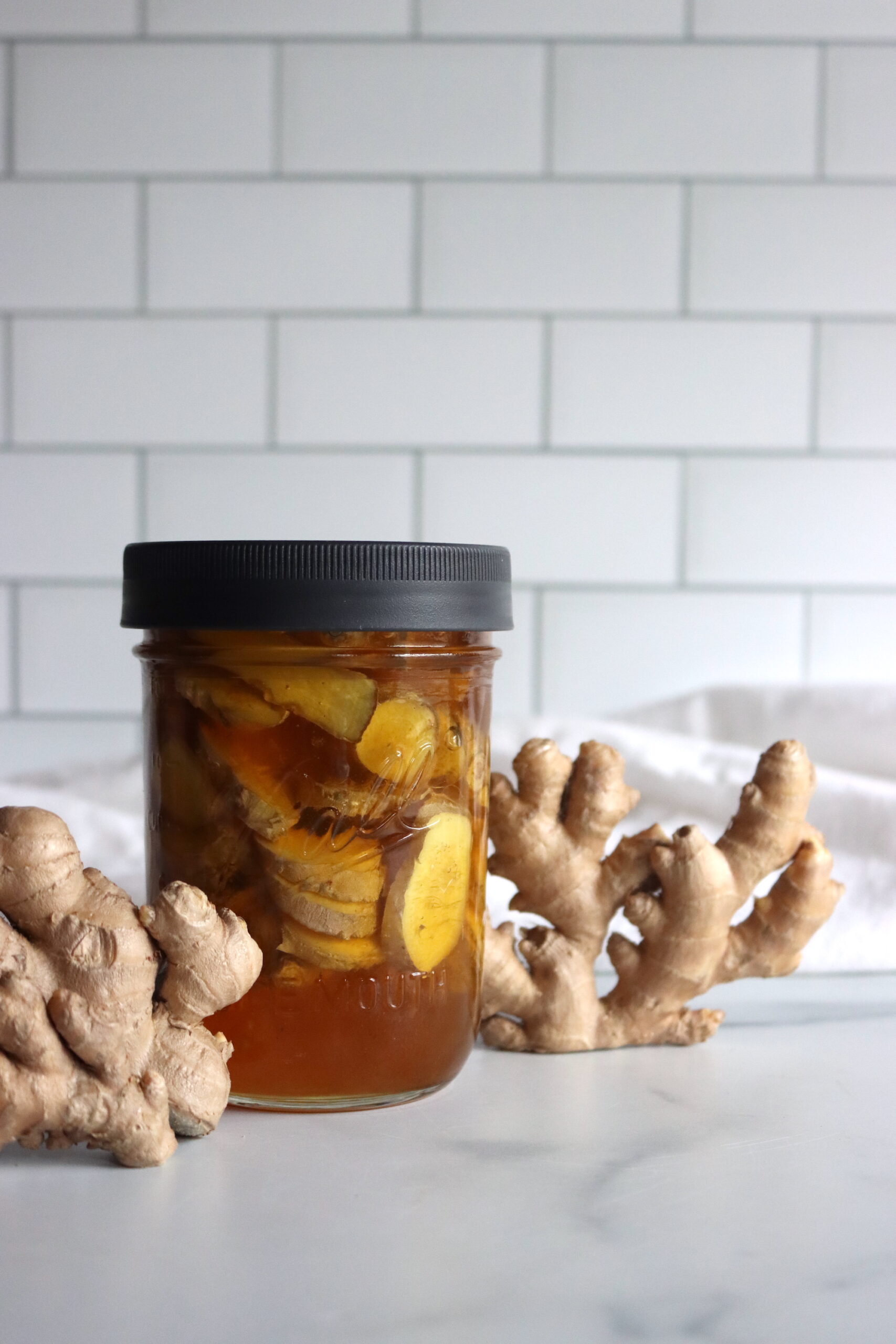
How Long Does It Take to Make?
The fermentation process is typically complete after 5 to 7 days at room temperature, but if you prefer a slower fermentation, you can store it in the fridge, and it will continue to develop over the course of several weeks. After the first few days of active fermentation, the process will slow down, but the ginger honey can be consumed at any point during this time.
The longer the ginger ferments in the honey, the more potent and mellow the flavor will become. The honey will also thicken and darken, and the ginger will become less pungent while still offering a mild, spicy warmth.
How Long Does Honey Fermented Ginger Last?
Honey-fermented ginger will last for several months when stored in a cool, dark place. If stored in the refrigerator, it can last even longer. Be sure to shake the jar every so often to keep the ginger submerged in the honey. This will help prevent any mold growth and keep the mixture fresh.
How to Use Honey Fermented Ginger
Honey-fermented ginger can be taken straight from the jar as a daily immune booster or tonic. A teaspoon or tablespoon can be swallowed directly, or you can stir it into warm water or tea for a soothing drink. The fermented honey can also be used in cooking, added to marinades, salad dressings, or even drizzled over roasted vegetables for an extra kick.
The combination of sweet honey and warming ginger creates a natural remedy that’s easy to incorporate into daily life. Whether you’re fighting off a cold or just want to support your digestive system, honey-fermented ginger is a powerful ally in your wellness toolkit.

Honey Fermented Ginger
Equipment
Ingredients
- 1 to 1 1/2 cups fresh ginger root, sliced but not peeled
- 6 ounces raw honey, 170g
- Optional: 1-2 tablespoons raw apple cider vinegar
Instructions
- Slice the ginger root into thin coins or small chunks and place it into a clean mason jar.
- Pour raw honey over the ginger, filling the jar to about 1 inch from the top.
- Add apple cider vinegar if desired.
- Close the jar tightly, shake gently to combine, then loosten the lid so that the fermentation bubbles can escape.
- Leave at room temperature for 2 to 5 days, shaking occasionally. Make sure you tighten the lid before shaking and then loosen it again afterward.
- After 5 days, refrigerate or store in a cool place to slow the fermentation process.
- Use the honey fermented ginger as a tonic, in teas, or as a flavorful ingredient in cooking.
Nutrition
Nutrition information is automatically calculated, so should only be used as an approximation.
Ginger Remedies
Looking for more ways to incorporate ginger into your herbal medicine cabinet?



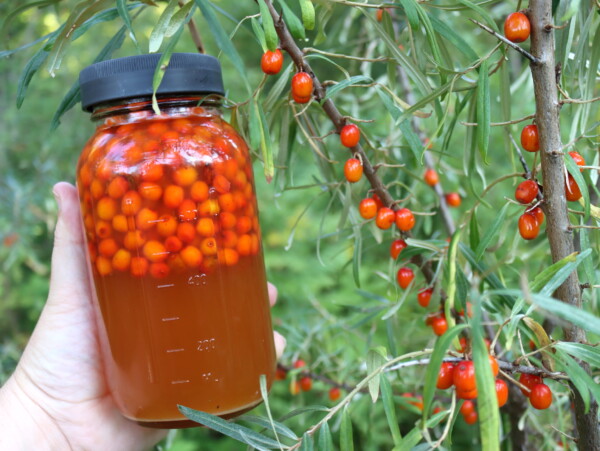
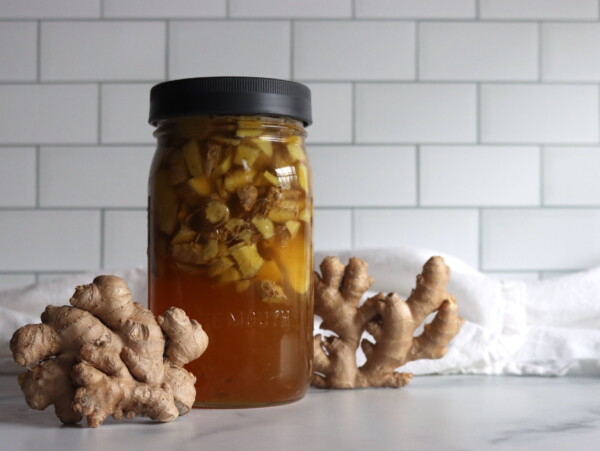










Great information. It was delicious! I love the information you share.
I was just wondering if I could do this with my extra ginger. Thank you! Gonna go get this done.
Wonderful! Let me know how you like it.